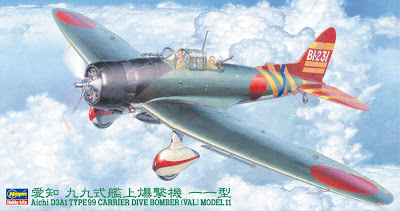Historical Background
In 1936, the Japanese Navy issued a specification for a monoplane dive-bomber to replace the Aichi D1A 'Susie' then in service. Mitsubishi, Nakajima and Aichi submitted their proposals - only Mitsubishi failed to get to the prototype stage. The wings of the Aichi proposal were inspired by Heinkel's He 70 while fixed landing gear was used for simplicity; the low speed of the aircraft also contributed towards it. The aircraft was powered by a 710hp Nakajima Hikari 1 radial engine. However initial tests proved disappointing, so the second prototype was modified to redress the problems. The Hikari engine was replaced with 840hp Mitsubishi Kinsei 3 in a redesigned cowling. The wings were slightly lengthened and stronger dive-brakes fitted. The outer sections of the leading edge have washouts to counter snap roll problem and the vertical tail enlarged to imrpove directional stability. The changes fixed all the problems except directional instability and ensured that Aichi's proposal prevailed over Nakajima's D3N1.
In December 1939, the Japanese Navy ordered the D3A as Navy Type 99 Carrier Bomber Type 11. Production models differed from the prototype with slightly smaller wings, more powerful Kinsei 43 (1,000hp) or Kinsei 44 (1,070hp) engine and a long dorsal fin which eliminated the stability problem. The changes also made the aircraft more maneuverable, and like Douglas' SBD, can be used as emergency interceptor aircraft. The D3A was armed with two fixed forward-firing 7.7mm machine guns and a flexible 7.7mm machine gun in the rear cockpit for self-defence. Normal bombload was a single 250-kg bomb under the fuselage and two 60-kg bombs under the wings. Carrier qualification trials were done during 1940 on board the
Akagi and
Kaga. The D3A1 were present in all major naval engagements in the first 10 months of the Pacific War. Apart from the Pearl Harbor attack (which the D3A1 worked in conjunction with Nakajima B5N level- and torpedo-bomber), the 'Val' (name given to the D3A1 by the Allies) were responsible for sinking more Allied warships than any other Axis aircraft. Notable victims of the 'Val' include HMS
Hermes, HMS
Dorsetshire, USS
Langley and, also in conjunction with the Kate, USS
Hornet.
In 1942, an improved version, known as D3A2 or Type 12 were introduced and surviving Type 11s were relegated to training units.
The Kit
Hasegawa originally released a 1/48 kit of the Val in the 1970s. To keep up with the times they released a new tooling of the Val in 1999 (which is this kit). The kit came in six sprues with good detail overall. The clear parts include separate canopy panels so one can pose them in the open position. Decals for two aircraft were provided: a green/grey machine from carrier
Soryu during the attack on Pearl Harbor (more on this later) and a
ame-iro-painted aircraft from carrier
Zuikaku, also during the attack on Pearl Harbor. Actually one can built almost any Vals participating in the raid as the sheet includes a 'number jungle' for aircraft from all six carriers of the
Kido Butai.
Construction
The cockpit, as usual. received the first attention. The Val's interior colour was different from other Japanese aircraft of the same era. Hasegawa specified a mixture of Gunze Yellow, Green and Brown for that bamboo-ish colour. I did not have the Gunze paints so I substituted them with Tamiya's equivalent. Detail parts were painted in their specific colours. The rear gun can be made in the 'up' or stowed position - I chose the 'up' position. The fuselage halves was then mated together, followed by the wings and tailplanes. Fit of the wing to fuselage was not good though and I have to fill the resulting gap with putty. However I failed to take into account putty shrinkage which still caused a bit of gap on the right wing (smaller than previously, though). The engine were next, painted in Mr. Color 28 Steel and dry-brushed Mr. Color 8 Silver before being enclosed in the cowling. Smaller parts, dive brakes, canopy parts and external loads were left off until later.
Painting and Decaling
I chose the marking option for the Val flown by Lt. Commander Engusa from the carrier
Soryu during the Pearl Harbor attack. However, research have shown that Lt. Cdr Engusa probably flew an
ame-iro painted Val, just like every other Vals during the attack. However he did fly the green/grey machine during the Indian Ocean raids in March 1942. Hasegawa specified that the green is a mixture of their Mitsubishi Green and Yellow. I did not have the former, so I substituted it with Tamiya XF-11 IJN Green. The bottom colour was painted using XF-12 IJN Grey. The cowling was painted using XF-69 NATO Black. The tailplane and stabilisers were painted XF-7 Red.
Once the paint was fully dry, it's off to the decaling stage. Hasegawa's decals are quite thick but they responded well to Mr Mark Decal Softer. There weren't much markings to fix though, just the Hinomarus, tail markings, wheel spat markings and the rear marking stripes. Tamiya Flat Clear spray was then used to seal everything off.
Finishing
The smaller parts can now be attached to the model. One note: the ring-and-bead sight could be better represented by a photo-etch metal part. The canopy parts were then stacked according to the instructions except for the pilot's, which I put it in the closed position. The Val was then subjected to a sludge wash.
Conclusion
Some modeler might go crazy with aftermarket stuff to build their models but I think Hasegawa's Val is a good kit by itself out-of-the box. There was really no problem, except for that wing to fuselage fit.







No comments:
Post a Comment